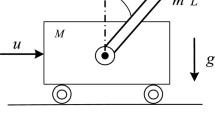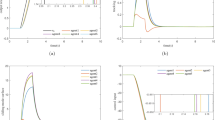Abstract
An immune algorithm and a technique of sliding mode variable structure control (VSC) are proposed to achieve real-time and accurate control of wheeled robot in view of uncertainties for time-varying, strong coupling and nonlinear characteristics of wheeled robots, coupled with change of load and influence of external disturbance in traditional control algorithm based on classical control theory. First, the VSC parameters are adjusted online by the immune algorithm, which overcomes limitation that the parameters of reaching law need to be set in advance in conventional VSC. Secondly, the algorithm not only retains advantages of the traditional reaching law, but also effectively improves control quality and eliminates chattering of the system. The experimental results show that the control technique makes the wheeled robot move on sliding surface in an ideal way, for main concern of this paper is to provide an effective systemic for control of wheeled robot.









Similar content being viewed by others
Change history
06 December 2021
An Editorial Expression of Concern to this paper has been published: https://doi.org/10.1007/s11370-021-00396-1
References
Park BS, Yoo SJ (2017) A low-complexity tracker design for uncertain nonholonomic wheeled mobile robots with time-varying input delay at nonlinear dynamic level. Nonlinear Dyn 89(3):1705–1717
Zhao X, Ren C, Liu H et al (2014) Research on fuzzy proportional–integral–derivative control of master–slave minimally invasive operation robot driver. J Biomed Eng 31(6):1346–1349
Khosravi MA, Taghirad HD (2014) Robust PID control of fully-constrained cable driven parallel robots. Mechatronics 25(2):87–97
Krzysztof K, Jarosław M (2002) A new control algorithm for a nonholonomic mobile robot. Arch Control Sci 12(1):37–69
Moravec J, Pošík P (2014) A comparative study: the effect of the perturbation vector type in the differential evolution algorithm on the accuracy of robot pose and heading estimation. Evol Intel 6(3):171–191
Juang C-F, Lai M-G, Zeng W-T (2014) Evolutionary fuzzy control and navigation for two wheeled robots cooperatively carrying an object in unknown environments. IEEE Trans Cybern 45(9):1731–1743
Azimi MM, Koofigar HR (2014) Adaptive fuzzy backstepping controller design for uncertain underactuated robotic systems. Nonlinear Dyn 79(2):1457–1468
Jang JO (2011) Adaptive neuro-fuzzy network control for a mobile robot. J Intell Robot Syst 62(3–4):567–586
Li SM, Guoliang HW (2005) Tracking control of car-like mobile robot based on backstepping. J Southeast Univ (Nat Sci Ed) 35(2):248–252
Vaidyanathan S, Sampath S (2012) Anti-synchronization of four-wing chaotic systems via sliding mode control. Int J Autom Comput 9(3):274–279
Giap NH, Shin JH, Kim WH (2008) Adaptive robust fuzzy control for path tracking of a wheeled mobile robot. Artif Life Robot 13(1):134–138
Yu W, Wang H, Cheng F et al (2017) Second-order consensus in multiagent systems via distributed sliding mode control. IEEE Trans Cybern 47(8):1872–1881
Xue Y, Zheng B-C, Yu X (2018) Robust sliding mode control for T–S fuzzy systems via quantized state feedback. IEEE Trans Fuzzy Syst 26(4):2261–2272
Wang F, Hua C, Zong Q (2018) Novel smooth sliding mode attitude control design for constrained re-entry vehicle based on disturbance observer. Int J Syst Sci 50(3):1–16
Biswash SK, Sarkar M, Sharma DK (2018) Artificial immune system (AIS)-based location management scheme in mobile cellular networks. Iran J Comput Sci 1(4):227–236
Demis H, Dharshan K, Christopher S et al (2017) Neuroscience-inspired artificial intelligence. Neuron 95(2):245–258
Valarmathy DS, Vanitha NS (2017) Feature selection optimization using artificial immune system algorithm for identifying dementia in MRI images. J Med Imaging Health Inform 7(1):73–78
Do TD, Hui SC, Fong ACM et al (2019) Associative classification with artificial immune system. IEEE Trans Evol Comput 13(2):217–228
Acknowledgements
This work is partially supported by Scientific and Technological Project under Grants 20130321005-04 and 20140311027-02. The authors also gratefully acknowledge the helpful comments and suggestions of the reviewers, which have improved the presentation.
Author information
Authors and Affiliations
Corresponding author
Additional information
Publisher's Note
Springer Nature remains neutral with regard to jurisdictional claims in published maps and institutional affiliations.
Rights and permissions
About this article
Cite this article
Lan, Y., Chen, X. Trajectory tracking system of wheeled robot based on immune algorithm and sliding mode variable structure. Intel Serv Robotics 16, 231–241 (2023). https://doi.org/10.1007/s11370-020-00325-8
Received:
Accepted:
Published:
Issue Date:
DOI: https://doi.org/10.1007/s11370-020-00325-8




